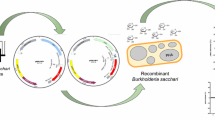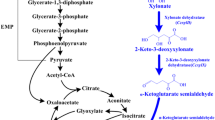Abstract
This study examined the continuous cofermentation performance characteristics of a dilute-acid “prehydrolysate-adapted” recombinant Zymomonas 39676:pZB4L and builds on the pH-stat batch fermentations with this recombinant that we reported on last year. Substitution of yeast extract by 1% (w/v) corn steep liquor (CSL) (50% solids) and Mg (2 mM) did not alter the coferm entation performance. Using declared assumptions, the cost of using CSL and Mg was estimated to be 12.5c/gal of ethanol with a possibility of 50% cost reduction using fourfold less CSL with 0.1% diammonium phosphate. Because of competition for a common sugar transporter that exhibits a higher affinity for glucose, utilization of glucose was complete whereas xylose was always present in the chemostat effluent. The ethanol yield, based on sugar used, was 94% of theoretical maximum. Altering the sugar ratio of the synthetic dilute acid hardwood prehydrolysate did not appear to significantly change the pattern of xylose utilization. Using a criterion of 80% sugar utilization for determining the maximum dilution rate (D max), changing the composition of the feed from 4% xylose to 3%, and simultaneously increasing the glucose from 0.8 to 1.8% shifted D max from 0.07 to 0.08/h. With equal amounts of both sugars (2.5%), D max was 0.07/h. By comparison to a similar investigation with rec Zm CP4:pZB5 with a 4% equal mixture of xylose and glucose, we observed that at pH 5.0, the D max was 0.064/h and shifted to 0.084/h at pH 5.75. At a level of 0.4% (w/v) acetic acid in the CSL-based medium with 3% xylose and 1.8% glucose at pH 5.75, the D max for the adapted recombinant shifted from 0.08 to 0.048/h, and the corresponding maximum volumetric ethanol productivity decreased 45%, from 1.52 to 0.84 g/(L·h). Under these conditions of continuous culture, linear regression of a Pirt plot of the specific rate of sugar utilization vs D showed that 4 g/L of acetic acid did not affect the maximum growth yield (0.030 g dry cell mass/g sugar), but did increase the maintenance coefficient twofold, from 0.46 to 1.0 g of sugar/(g of cell·h).
Similar content being viewed by others
References
Jeffries, T. W. (1981), Biotechnol. Bioeng. Symp. 11, 315–324.
Hinman, N. D., Wright, J. D., Hoagland, W., and Wyman, C. E. (1989), Appl. Biochem. Biotechnol. 20/21, 391–401.
McMillan, J. D. (1994), in Enzymatic Conversion of Biomass for Fuels Production, Himmel, M. E., Baker, J. O., and Overend, R. A., eds., ACS Symposium Series 566, American Chemical Society, Washington, DC, pp. 411–437.
Hahn-Hägerdal, B., Hallborn, J., Jeppsson, H., Olsson, L., Skoog, K., and Walfridsson, M. (1993), in Bioconversion of Forest and Agricultural Plant Residues, Saddler, J. N., ed., C. A. B. International, Wallingford, UK, pp. 411–437.
Barbosa, M. de F. S., Beck, M. J., Fein, J. E., Potts, D., and Ingram, L. O. (1992), Appl. Environ. Microbiol. 58, 1382–1389.
Beall, D. S., Ingram, L. O., Ben-Bassat, A., Doran, J. B., Fowler, D. E., Hall, R. G., and Wood, B. E. (1992), Biotechnol Lett. 14, 857–862.
Lawford, H. G. and Rousseau, J. D. (1993), Biotechnol. Lett. 15, 615–620.
DiMarco, A. A. and Romano, A. (1985), Appl. Environ. Microbiol. 49, 151–157.
Parker, C., Barnell, W. O., Snoep, J. L., Ingram, L. O., and Conway, T. (1995), Mol. Microbiol. 15, 795–802.
Rogers, P. L. and Lawford, H. G. (1999), 21st Symposium on Biotechnology for Fuels and Chemicals, May 2–6, Fort Collins, CO, Abstract 2-01.
Booth, I. R. (1985), Microbiol. Rev. 49, 63–91.
Lawford, H. G., Rousseau, J. D., and McMillan, J. D. (1997), Appl. Biochem. Biotechnol. 63–65, 269–286.
Lawford, H. G. and Rousseau, J. D. (1998), Appl. Biochem. Biotechnol. 70–72, 161–172.
Joachimsthal, E., Haggett, K. D., Jang, J.-H., and Rogers, P. L. (1998), Biotechnol. Lett. 20, 137–142.
McMillan, J. D. (1997), Renew. Energy 10, 295–302.
McMillan, J. D., Newman, M. M., Templeton, D. W., and Mohagheghi, A. (1999), Appl. Biochem. Biotechnol. 77–79, 649–665.
Picataggio, S. K., Zhang, M., Eddy, C. K., Deanda, K. A., and Finkelstein, M. (1996), US patent 5,514,583.
Zhang, M., Eddy, C., Deanda, K., Finkelstein, M., and Picataggio, S. K. (1995), Science 267, 240–243.
Lawford, H. G., Rousseau, J. D., Mohagheghi, A., and McMillan, J. D. (1999), Appl. Biochem. Biotechnol. 77–79, 191–204.
Joachimsthal, E., Haggett, K. D., and Rogers, P. L. (1999), Appl. Biochem. Biotechnol. 77–79, 147–158.
Lawford, H. G., Rousseau, J. D., Mohagheghi, A., and McMillan, J. D. (1998), Appl. Biochem. Biotechnol. 70–72, 353–368.
Pirt, S. J. (1975), in Principles of, Microbe and Cell Cultivation, Blackwell Scientific, London, pp. 66–68.
Nguyen, Q. A., Dickow, J. H., Duff, B. W., Farmer, J. D., Glassner, D. A., Ibsen, K. N., Ruth, M. F., Schell, D. J., Thompson, I. B., and Tucker, M. P. (1996), Bioresour. Technol. 58, 189–196.
Lawford, H. G. and Rousseau, J. D. (1997), Appl. Biochem. Biotechnol. 63–65, 287–304.
Goodman, A. E., Rogers, P. L., and Skotnicki, M. L. (1982), Appl. Environ. Microbiol. 44, 496–498.
von Sivers, M., Zacchi, G., Olsson, L., and Hahn-Hägerdal, B. (1994), Biotechnol. Prog. 10, 555–560.
Rogers, P. L., Joachimsthal, E. L., and Haggett, K. D. (1997), J. Australasian Biotechnol. 7, 304–309.
Lawford, H. G. and Rousseau, J. D. (2000), Appl. Biochem. Biotechnol. 84–86, this volume.
Kompala, D., Ruth, M., and McMillan, J. D. (1999), 21st Symposium on Biotechnology for Fuels and Chemicals, May 2–6, Fort Collins, CO, Abstract 3-05.
Author information
Authors and Affiliations
Corresponding author
Rights and permissions
About this article
Cite this article
Lawford, H.G., Rousseau, J.D., Mohagheghi, A. et al. Continuous fermentation studies with xylose-utilizing recombinant Zymomonas mobilis . Appl Biochem Biotechnol 84, 295–310 (2000). https://doi.org/10.1385/ABAB:84-86:1-9:295
Issue Date:
DOI: https://doi.org/10.1385/ABAB:84-86:1-9:295




